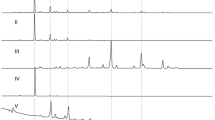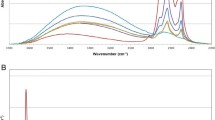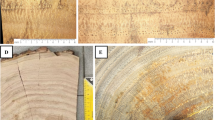Summary
Polyflavonoid tannins are proven to be fast-reacting with CCA solutions and hence, to be strong competitors of the structural wood constituents for fixation of CCA preservatives. The consequence of this effect is that even relatively small amounts of tannin cause severe undertreatment of the structural wood constituents which in turn badly affects the long term durability of CCA treated timber. The effect is compounded by heavy disproportionation between tannins and structural wood constituents of Cu, Cr and As. This leads to the well-known high susceptibility to soft-rot attack in eucalyptus species and in vineyard posts even experienced with some susceptible softwoods. Relationships found by other authors between soft-rot incidence and lignin content in CCA-treated timber are proven here to be only part of the total failure mechanism. The total mechanisms of resistance and failure are due to the balance of distribution of reactions among the various proportions of highly reactive tannins and more abundant but less reactive lignin and carbohydrates present in any wood. As a consequence of the clarification of these mechanisms the liability of different woods to soft-rot attack can then be accurately determined. Solutions to the problem are presented and discussed.
Similar content being viewed by others
References
American Wood Preservers Association 1971: Specification for waterborne preservatives. AWPA standard P5-71
American Society for Testing and Materials 1971: specification for chromated copper arsenate. ASTM standard D1625-68
Butcher, J. A.; Nilsson, T. 1982: Influence of variable lignin content amongst hardwoods on soft-rot susceptibility and performance of CCA preservatives. International Research Group on Wood Preservation Document IRG/WP/1151, Stockholm, Sweden
Butcher, J. A. 1983: Private communications
Garbutt, D. 1985: Institute for Commercial Forestry Research, Pietermaritzburg, South Africa. Personal communication.
Hedley, M. E. 1983: Inadequacies in preservative retention and formulation as contributory causes of premature failure of CCA-treated vineyard posts. Presented at Tanalith 83 Conference, Auckland, New Zealand
Jansen, A.; Conradie, W. E.; Pizzi, A. 1984: The penetration characteristics of CCA preservatives in wood. Part 1: radial/tangential, processes and species effects Holz Roh-Werkstoff (accepted for publication)
Jenkin, D. J. 1984: Adhesives from Pinus radiata bark extractives. J. Adhesion 16: 299–310
Kubel, A.; Pizzi, A. 1981: Protection of wood surfaces with metallic oxides, Holzforsch. Holzverwert. 33: 11–14
Leightley, L. E. 1983: Wood preservation requirements in Queensland, Australia. Symposium on wood preservation, Pretoria, South Africa
Nilsson, T. 1982: Comments on soft-rot attack in timbers treated with CCA preservatives: A document for discussion. International Research Group on Wood Preservation document IRG/WP/1167, Stockholm, Sweden
Peek, R. D.; Willeitner, H. 1981: Beschleunigte Fixierung chromathaltiger Holzschutzmittel durch Heißdampfbehandlung. 1. Mitteilung: Einfluß verschiedener Wärmebehandlungen auf die Auswaschung von Schutzsalzen, Holz Roh-Werkstoff 39: 495–502
Pizzi, A. 1979: Wood waterproofing and lignin cross-linking by means of chromium trioxide/guaiacyl units complexes. Holzforsch. Holzverwert. 31: 128–131
Pizzi, A. 1981: The chemistry and kinetic behaviour of Cu-Cr-As/B wood preservatives. I. Fixation of chromium on wood. J. Polym. Sci., Chem. Ed. 19: 3093–3121
Pizzi, A. 1983: The chemistry and kinetic behaviour of Cu-Cr-As/B wood preservatives. IV. Fixation of CCA to wood. J Polym. Sci. Chem. Ed. 20: 739–764
Pizzi, A. 1983: A new approach to the formulation and application of CCA preservatives, Wood Sci. Technol. 17: 303–319
Pizzi, A.; Conradie, W. E. 1984: Unpublished data
Richardson, B. A. 1978: Wood preservation. Lancaster: The Construction Press,
Slabbert, N. P. 1972: Metal complexes of black wattle tannins and related model polyphenols. Ph.D. thesis, Rhodes University, Grahamstown, South Africa
South African Bureau of Standards specification SABS 673-1976: Mixtures of copper-chromearsenic compounds for timber preservation
Swann, D. A.; Stuart, K. R.; Russel, D. C.; Chiang, C. L. 1976: New Zealand patent 179933, 11. Febr. 1976
Vogel, M. C.; Pizzi, A.; Conradie, W. E. 1983: Comparative leaching tests of Cu, Cr and As from timber treated with CCA types I and II (C and B). CSIR Special Report HOUT 308, Pretoria, South Africa
Author information
Authors and Affiliations
Rights and permissions
About this article
Cite this article
Pizzi, A., Conradie, W.E. & Jansen, A. Polyflavonoid tannins — a main cause of soft-rot failure in CCA-treated timber. Wood Sci.Technol. 20, 71–81 (1986). https://doi.org/10.1007/BF00350695
Received:
Issue Date:
DOI: https://doi.org/10.1007/BF00350695




